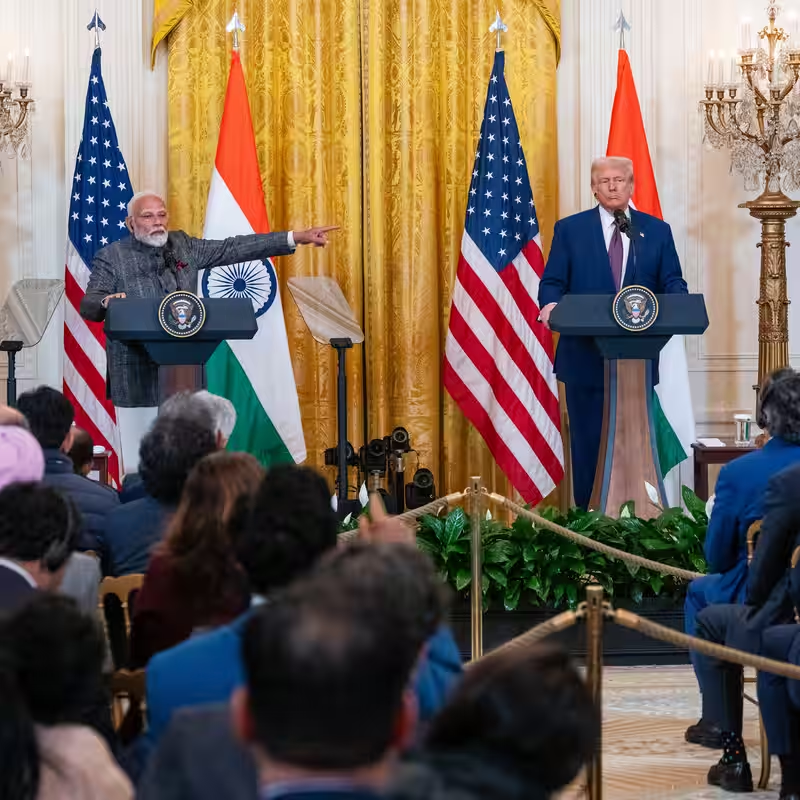Table of Contents
- A Diplomatic Dance Amid Trade Tensions
- Trump’s Bold Assertion—and India’s Measured Response
- Why India Won’t Easily Quit Russian Oil
- The Lingering U.S.-India Trade Dispute
- Walking a Geopolitical Tightrope
- Sources
A Diplomatic Dance Amid Trade Tensions
On Thursday, October 16, 2025, India offered a carefully worded response to U.S. President Donald Trump’s latest claim that Prime Minister Narendra Modi had promised to halt purchases of Russian oil. Rather than issuing a direct denial, New Delhi chose subtlety—underscoring its long-standing policy of energy diversification while sidestepping confrontation.
This cautious approach reflects India’s broader strategy: to de-escalate a simmering trade dispute with Washington without compromising its energy security or strategic autonomy.
Trump’s Bold Assertion—and India’s Measured Response
Speaking on Wednesday, President Trump declared that Modi had “assured me today that he will not be buying Russian oil,” framing the move as a step toward curbing Moscow’s war efforts in Ukraine. However, Indian officials quickly cast doubt on the claim.
Randhir Jaiswal, spokesperson for India’s Ministry of External Affairs, stated during a press briefing that he had “no knowledge of a call between the two leaders in recent days.” Notably, his tone was more restrained than in previous instances—when similar Trump remarks triggered sharper rebuttals from New Delhi.
Instead of outright contradiction, India emphasized its consistent approach to oil imports: “India has always sought a diverse range of suppliers,” the foreign ministry noted in a statement.
Why India Won’t Easily Quit Russian Oil
Since Russia’s invasion of Ukraine in 2022, India has dramatically increased its purchases of discounted Russian crude—rising from negligible volumes to becoming one of Moscow’s top buyers. This shift has saved India billions in energy costs and helped stabilize domestic fuel prices.
Abandoning this arrangement abruptly would not only strain India’s economy but also undermine its leverage in global energy markets. Analysts say New Delhi is unlikely to make such a concession without significant U.S. trade concessions in return.
Key Stats: India’s Russian Oil Imports (2022–2025)
| Year | % of Total Oil Imports from Russia | Avg. Daily Volume (Barrels) |
|---|---|---|
| 2022 | 2% | 30,000 |
| 2023 | 35% | 1.2 million |
| 2024 | 42% | 1.6 million |
| 2025 (YTD) | 38% | 1.4 million |
The Lingering U.S.-India Trade Dispute
Tensions between Washington and New Delhi have escalated since August 2025, when the Trump administration slapped a second 25% tariff on Indian goods—bringing total punitive duties to 50% on select exports like textiles, pharmaceuticals, and steel products.
The move was explicitly tied to India’s continued oil trade with Russia. U.S. officials argue that New Delhi’s purchases indirectly fund Moscow’s military operations. India, however, maintains that its energy decisions are sovereign and that it remains neutral on the Ukraine conflict.
Prime Minister Modi’s government is now walking a fine line: seeking tariff relief without appearing to capitulate to U.S. pressure.
Walking a Geopolitical Tightrope
India’s response exemplifies its broader foreign policy doctrine—strategic autonomy. While deepening defense and tech ties with the U.S., India continues robust partnerships with Russia, especially in arms and energy.
Observers note that Modi’s administration is unlikely to make public concessions that could be perceived as bowing to American demands. Yet behind closed doors, quiet diplomacy may be paving the way for a compromise.
For now, India’s message is clear: it will manage its energy portfolio on its own terms—even as it works to mend fences with Washington.




